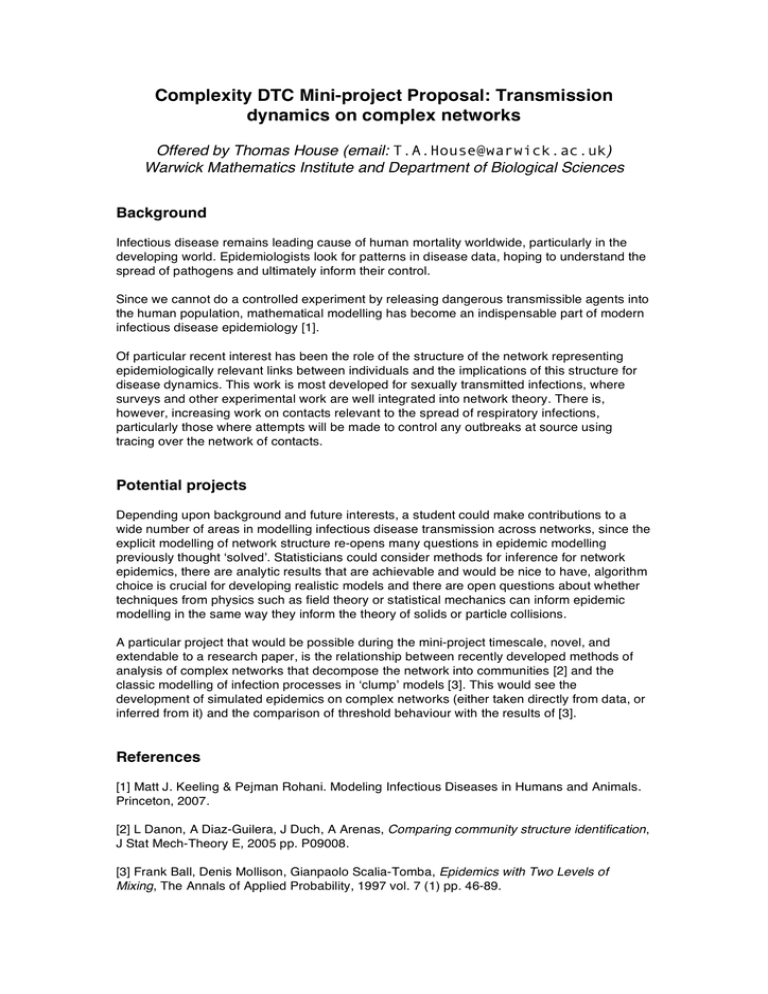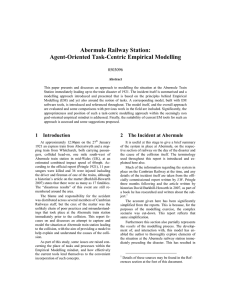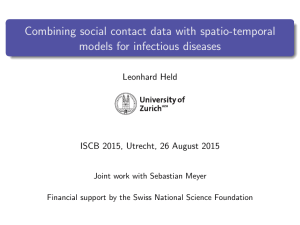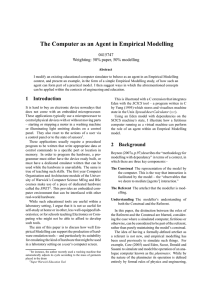Complexity DTC Mini-project Proposal: Transmission dynamics on complex networks
advertisement

Complexity DTC Mini-project Proposal: Transmission dynamics on complex networks Offered by Thomas House (email: T.A.House@warwick.ac.uk) Warwick Mathematics Institute and Department of Biological Sciences Background Infectious disease remains leading cause of human mortality worldwide, particularly in the developing world. Epidemiologists look for patterns in disease data, hoping to understand the spread of pathogens and ultimately inform their control. Since we cannot do a controlled experiment by releasing dangerous transmissible agents into the human population, mathematical modelling has become an indispensable part of modern infectious disease epidemiology [1]. Of particular recent interest has been the role of the structure of the network representing epidemiologically relevant links between individuals and the implications of this structure for disease dynamics. This work is most developed for sexually transmitted infections, where surveys and other experimental work are well integrated into network theory. There is, however, increasing work on contacts relevant to the spread of respiratory infections, particularly those where attempts will be made to control any outbreaks at source using tracing over the network of contacts. Potential projects Depending upon background and future interests, a student could make contributions to a wide number of areas in modelling infectious disease transmission across networks, since the explicit modelling of network structure re-opens many questions in epidemic modelling previously thought ʻsolvedʼ. Statisticians could consider methods for inference for network epidemics, there are analytic results that are achievable and would be nice to have, algorithm choice is crucial for developing realistic models and there are open questions about whether techniques from physics such as field theory or statistical mechanics can inform epidemic modelling in the same way they inform the theory of solids or particle collisions. A particular project that would be possible during the mini-project timescale, novel, and extendable to a research paper, is the relationship between recently developed methods of analysis of complex networks that decompose the network into communities [2] and the classic modelling of infection processes in ʻclumpʼ models [3]. This would see the development of simulated epidemics on complex networks (either taken directly from data, or inferred from it) and the comparison of threshold behaviour with the results of [3]. References [1] Matt J. Keeling & Pejman Rohani. Modeling Infectious Diseases in Humans and Animals. Princeton, 2007. [2] L Danon, A Diaz-Guilera, J Duch, A Arenas, Comparing community structure identification, J Stat Mech-Theory E, 2005 pp. P09008. [3] Frank Ball, Denis Mollison, Gianpaolo Scalia-Tomba, Epidemics with Two Levels of Mixing, The Annals of Applied Probability, 1997 vol. 7 (1) pp. 46-89.




